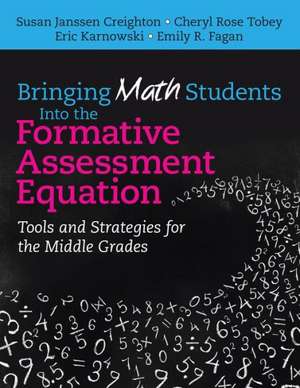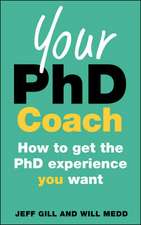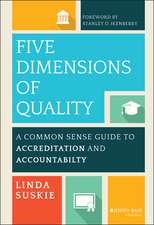Bringing Math Students Into the Formative Assessment Equation: Tools and Strategies for the Middle Grades
Autor Susan Creighton, Cheryl Rose Tobey, Eric E. Karnowski, Emily R. Faganen Limba Engleză Paperback – 16 mar 2015
- Downloadable PDF and Word versions of handouts described in the book
- Sample lesson plans
- Video examples
- Interactive learning activities
- Planning tools (PDF templates and interactive web pages)
Preț: 295.03 lei
Nou
Puncte Express: 443
Preț estimativ în valută:
56.46€ • 61.31$ • 47.43£
56.46€ • 61.31$ • 47.43£
Carte tipărită la comandă
Livrare economică 23 aprilie-07 mai
Preluare comenzi: 021 569.72.76
Specificații
ISBN-13: 9781483350103
ISBN-10: 148335010X
Pagini: 312
Dimensiuni: 216 x 279 x 27 mm
Greutate: 0.86 kg
Ediția:1
Editura: SAGE Publications
Colecția Corwin
Locul publicării:Thousand Oaks, United States
ISBN-10: 148335010X
Pagini: 312
Dimensiuni: 216 x 279 x 27 mm
Greutate: 0.86 kg
Ediția:1
Editura: SAGE Publications
Colecția Corwin
Locul publicării:Thousand Oaks, United States
Recenzii
“This
book
not
only
provides
the
skills
for
both
teachers
and
students
to
take
part
in
the
formative
assessment
process,
but
demonstrates
a
high
level
of
the
thinking
required
when
teachers
plan
lessons.”
“This book would be extremely helpful in helping my students learn to focus 1) consider and articulate the mathematics understanding, 2) shift their focus to making sense of student understanding, and 3) realize that true teaching is then acting on the gap between the understandings the student holds and the full set of understandings that you would like them to hold.”
“This book was outstanding, and I would recommend it to any math educator. The depth of research integrated into practice is extensive and, as a result, is the most practical book I have seen related to either formative assessment or mathematics. The most helpful aspect of the book is the affective nature so often ignored in educational works. The self-regulation aspects, as well as the ownership and involvement emphasized in the book went beyond the traditional cognitive strategies endorsed in most books.”
?“The ideas [in this book] are brought to life with mathematics examples of teachers and students in the classroom. The teacher voices, comments, and quotes lend credibility and are a big component of the book’s strengths as well as the visuals and graphics.”
“This book would be extremely helpful in helping my students learn to focus 1) consider and articulate the mathematics understanding, 2) shift their focus to making sense of student understanding, and 3) realize that true teaching is then acting on the gap between the understandings the student holds and the full set of understandings that you would like them to hold.”
“This book was outstanding, and I would recommend it to any math educator. The depth of research integrated into practice is extensive and, as a result, is the most practical book I have seen related to either formative assessment or mathematics. The most helpful aspect of the book is the affective nature so often ignored in educational works. The self-regulation aspects, as well as the ownership and involvement emphasized in the book went beyond the traditional cognitive strategies endorsed in most books.”
?“The ideas [in this book] are brought to life with mathematics examples of teachers and students in the classroom. The teacher voices, comments, and quotes lend credibility and are a big component of the book’s strengths as well as the visuals and graphics.”
Cuprins
Chapter
1:
Using
Formative
Assessment
to
Build
Student
Engagement
in
Mathematics
Learning
Being a Self-Regulating Learner
Using Formative Assessment Practices to Develop Self-Regulation Skills
Using Formative Assessment in Your Classroom
Teaching Students How to Participate in Formative Assessment
How to Use this Book to Learn What You Want to Learn
Conclusion
Resources
Chapter 2: Using Mathematics Learning Intentions and Success Criteria
What Are Learning Intentions and Success Criteria?
Creating Learning Intentions and Success Criteria for Your Classroom
Conclusion
Resources
Chapter 3: Gathering, Interpreting, and Acting on Evidence
What Is Evidence?
Using Evidence in Your Classroom: The Teacher's Role
The Student's Role and How You Can Develop and Support It
Conclusion
Resources
Chapter 4: Providing and Using Formative Feedback
What Is Formative Feedback?
Using Formative Feedback in Your Classroom
Conclusion
Resources
Chapter 5: Developing Student Ownership and Involvement in Your Students
Student Ownership and Involvement
What Do Students Need to Learn?
Helping Students Develop Ownership and Involvement in Their Mathematics Learning
Self-Regulation: It's Not a Linear Process
Conclusion
Resources
Chapter 6: Using Mathematics Learning Progressions
What Is a Learning Progression?
How Can You Use Learning Progressions in Your Instruction?
Using Learning Progressions to Help Develop Student Ownership and Involvement
Conclusion
Resources
Chapter 7: Establishing a Classroom Environment
Elements of the Classroom Environment
The Social and Cultural Environment: Promoting Intellectual Safety and Curiosity
The Instructional Environment: Framing Instruction to Encourage and Make Visible Students' Thinking and to Optimize Learning
The Physical Environment: Keeping Resources Available
Conclusion
Resources
Chapter 8: Moving Toward Implementation
Implementation Principles for Formative Assessment
Sustaining Your Effort Over the Long Term
Conclusion: Final Words of Encouragement
Resources
Appendix A: Resources
Appendix B: Implementation Indicators for Formative Assessment
Being a Self-Regulating Learner
Using Formative Assessment Practices to Develop Self-Regulation Skills
Using Formative Assessment in Your Classroom
Teaching Students How to Participate in Formative Assessment
How to Use this Book to Learn What You Want to Learn
Conclusion
Resources
Chapter 2: Using Mathematics Learning Intentions and Success Criteria
What Are Learning Intentions and Success Criteria?
Creating Learning Intentions and Success Criteria for Your Classroom
Conclusion
Resources
Chapter 3: Gathering, Interpreting, and Acting on Evidence
What Is Evidence?
Using Evidence in Your Classroom: The Teacher's Role
The Student's Role and How You Can Develop and Support It
Conclusion
Resources
Chapter 4: Providing and Using Formative Feedback
What Is Formative Feedback?
Using Formative Feedback in Your Classroom
Conclusion
Resources
Chapter 5: Developing Student Ownership and Involvement in Your Students
Student Ownership and Involvement
What Do Students Need to Learn?
Helping Students Develop Ownership and Involvement in Their Mathematics Learning
Self-Regulation: It's Not a Linear Process
Conclusion
Resources
Chapter 6: Using Mathematics Learning Progressions
What Is a Learning Progression?
How Can You Use Learning Progressions in Your Instruction?
Using Learning Progressions to Help Develop Student Ownership and Involvement
Conclusion
Resources
Chapter 7: Establishing a Classroom Environment
Elements of the Classroom Environment
The Social and Cultural Environment: Promoting Intellectual Safety and Curiosity
The Instructional Environment: Framing Instruction to Encourage and Make Visible Students' Thinking and to Optimize Learning
The Physical Environment: Keeping Resources Available
Conclusion
Resources
Chapter 8: Moving Toward Implementation
Implementation Principles for Formative Assessment
Sustaining Your Effort Over the Long Term
Conclusion: Final Words of Encouragement
Resources
Appendix A: Resources
Appendix B: Implementation Indicators for Formative Assessment
Notă biografică
Descriere
A
professional
resource
for
teachers
that
addresses
the
implementation
of
formative
assessment
as
a
comprehensive
instructional
model.












